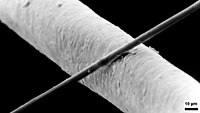
Photo from wikipedia
The present study experimentally and numerically investigated the impact behavior of composite reinforced concrete (RC) beams with the pultruded I-GFRP and I-steel beams. Eight specimens of two groups were cast… Click to show full abstract
The present study experimentally and numerically investigated the impact behavior of composite reinforced concrete (RC) beams with the pultruded I-GFRP and I-steel beams. Eight specimens of two groups were cast in different configurations. The first group consisted of four specimens and was tested under static load to provide reference results for the second group. The four specimens in the second group were tested first under impact loading and then static loading to determine the residual static strengths of the impacted specimens. The test variables considered the type of encased I-section (steel and GFRP), presence of shear connectors, and drop height during impact tests. A mass of 42.5 kg was dropped on the top surface at the mid-span of the tested beams from five different heights: 250, 500, 1000, 1500, and 1900 mm. Moreover, nonlinear Finite Element (FE) models were developed and validated using the experimental data. Static loading was defined as a displacement-controlled loading and the impact loading was modeled as dynamic explicit analysis with different drop velocities. The validated models were used to conduct a parametric study to investigate the effect of the concrete compressive strength on the performance of the composite beams under static and impact loadings. For the composite specimen with steel I-sction, the maximum impact force was 190% greater than the reference specimen NR-I at a drop height of 1900 mm, whereas the maximum impact forces for the specimens composite specimens with GFRP I-sction without and with shear connectors were 19% and 77%, respectively, more significant than the reference beam at the same drop height. The high stiffness for the steel I-beams relative to the GFRP I-beam was the reason for this difference in behavior. The concrete compressive strength was more effective in improving the impact behavior of the composite specimens relative to those without GFRP I-beams.
Journal Title: Materials
Year Published: 2022
Link to full text (if available)
Share on Social Media: Sign Up to like & get
recommendations!